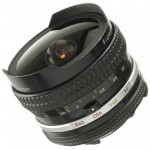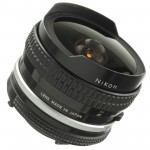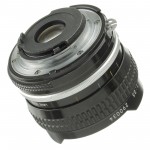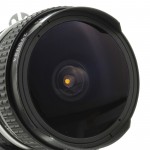Nikon AI Fisheye-Nikkor 16mm F/3.5
Fisheye lens • Film era • Discontinued
- Announced:
- · 1977
- Production status:
- ● Discontinued
- Country of design:
- · Japan
- Original name:
- · Nikon Fisheye-NIKKOR 16mm 1:3.5
- Class:
- · Slow full-frame diagonal fisheye lens
- System:
- · Nikon F (1959)
Abbreviations
| AI | A manual focus lens with automatic maximum aperture indexing, which is a mechanical system for coupling the lens to the camera's exposure system. Learn more |
| FISHEYE | An ultra-wide angle lens with strong uncorrected barrel distortion and extreme angle of view. |
Model history (3)
| ■Nikon Fisheye-Nikkor Auto 16mm F/3.5 | A | 8 - 5 | 0.30m | -- | 1973 ● | |
| ■Nikon Fisheye-Nikkor 16mm F/3.5 | A | 8 - 5 | 0.30m | -- | 1975 ● | |
| ■Nikon AI Fisheye-Nikkor 16mm F/3.5 | A | 8 - 5 | 0.30m | -- | 1977 ● | |
Specification
| Optical design: | |
| 35mm full frame | |
| 16mm | |
| F/3.5 | |
| 8 elements in 5 groups | |
| Diagonal (full-frame) fisheye | |
| Nikon F [46.5mm] | |
| 170° | |
| Diaphragm mechanism: | |
Diaphragm type: | Automatic |
Aperture control: | Aperture ring (Manual settings only) |
| 7 (seven) | |
| Focusing: | |
| 0.30m | |
| <No data> | |
Focusing modes: | Manual focus only |
Manual focus control: | Focusing ring |
| Physical characteristics: | |
| 330g | |
| ⌀68×51mm | |
| Accessories: | |
| Removable front filters are not accepted | |
| Built-in N, Y48, O56, R60 (part of the lens optical system) | |
| Built-in petal-shaped | |
| Not compatible |
Sources of data
- Manufacturer's technical data.
- Nikon Sales Manual (July 1977).
- Nikkor lenses sales manual (January 1979).
- Nikon Sales Manual (June 1978).
Manufacturer description #1
In contrast to other Fisheye-Nikkors which were primarily designed for scientific and industrial applications, this Fisheye-Nikkor has been designed to provide special effects in general photography. Other Fisheye-Nikkors produce a circular image on the film, but this lens delivers an image which fills the entire 24mm x 36mm film format. Its near hemispheric coverage of 170° provides extreme wideangle pictures with the dramatic perspective effect inherent in fisheye lenses.
With the combined effects of this Fisheye-Nikkor, the photographer can enjoy creating special ultra- wideangle effects - in advertising and other commercial photography, photojournalism and art photography. The lens is extremely portable, with its size and weight comparable to a normal lens. It has an automatic diaphragm and permits thru-the-Iens viewing and metering. Color aberration is well corrected, providing high contrast images even at full-aperture. The lens has three interchangeable filters plus one plain glass filter built into the lens barrel.
Manufacturer description #2
Sales Points
- Full-frame fisheye coverage of 170 degrees
- Very compact and lightweight - only 330 grams.
- Through-the-lens viewing and focusing down to one foot (0.3m).
- Built-in scalloped lens hood.
- Supplied with a set of 4 filters (plain glass, yellow, orange and red) built into a revolving turret and a slip-on front lens cap.
- Photographic uses include sweeping panoramic effects in sports, travel, photojournalism, advertising, and commercial work.
Typical characteristics of fisheye lenses
- Extreme angle of view (at least 180° diagonally);
- Circular types (the image circle of the lens is inscribed in the image frame) or diagonal types (cover the entire image frame);
- Usually of equidistant projection type, with the distance from the picture center to any given point always proportional to the angle from the optical axis to that point;
- Huge barrel distortion;
- Short closest focusing distance (0.20 - 0.30m with 35mm full-frame prime lenses);
- Very large depth of field, eliminating the need for autofocus or precise manual focusing;
- Due to the extreme angle of view and convex front element, front filters cannot be used;
- Often equipped with a filter turret with swivel-mounted filters;
- Often come with a small, built-in petal-shaped lens hood.
Notes
- This AI lens was designed for Nikon F3, EL2, EM, FE, FE2, FE10, FG-20, FM, FM2, FM10, FM3A, Nikkormat FT3 AI cameras and Nikon FA, FG, N2000, N6000 AI-S cameras.
- AI and AI-S lenses are backward compatible with Nikon F, F2, Nikkormat FS, FT, FT2, FTN, EL, ELW cameras.
- On Nikon digital SLR cameras, the automatic exposure metering with AI and AI-S lenses will not be available on D40, D40X, D60, D70, D70s, D80, D3000-D3500, D5000-D5600 series.
Other fisheye lenses in the Nikon F system
| ■Nikon F mount (14) | |||||||||
| Nippon Kogaku / Nikon Fisheye-Nikkor 6mm F/5.6 | M | 9 - 6 | -- | 1970 ● | |||||
| Nikon Fisheye-Nikkor Auto 6mm F/2.8 | A | 12 - 9 | 0.25m | -- | 1970 ● | ||||
| Nikon AI Fisheye-Nikkor 6mm F/2.8 | A | 12 - 9 | 0.25m | -- | 1977 ● | ||||
| Nikon AI-S Fisheye-Nikkor 6mm F/2.8 | A | 12 - 9 | 0.25m | -- | 1982 ● | ||||
| Nippon Kogaku Fisheye-Nikkor 7.5mm F/5.6 | M | 9 - 6 | -- | 1966 ● | |||||
| Nippon Kogaku Fisheye-Nikkor 8mm F/8 | M | 9 - 5 | -- | 1962 ● | |||||
| Nippon Kogaku / Nikon Fisheye-Nikkor Auto 8mm F/2.8 | A | 10 - 8 | 0.30m | -- | 1970 ● | ||||
| Nikon AI Fisheye-Nikkor 8mm F/2.8 | A | 10 - 8 | 0.30m | -- | 1977 ● | ||||
| Nikon AI-S Fisheye-Nikkor 8mm F/2.8 | A | 10 - 8 | 0.30m | -- | 1981 ● | ||||
| Nippon Kogaku / Nikon OP-Fisheye-Nikkor 10mm F/5.6 | M | 9 - 6 | -- | 1968 ● | |||||
| Nikon Fisheye-Nikkor Auto 16mm F/3.5 | A | 8 - 5 | 0.30m | -- | 1973 ● | ||||
| Nikon Fisheye-Nikkor 16mm F/3.5 | A | 8 - 5 | 0.30m | -- | 1975 ● | ||||
| Nikon AI Fisheye-Nikkor 16mm F/2.8 | A | 8 - 5 | 0.30m | -- | 1979 ● | ||||
| Nikon AI-S Fisheye-Nikkor 16mm F/2.8 | A | 8 - 5 | 0.30m | -- | 1981 ● | ||||
Lenses with similar focal length
| ■Nikon F mount (5) | |||||||||
| Sigma MF 15mm F/2.8 Fisheye Multi-Coated ZEN | A | 8 - 7 | 0.15m | -- | 1990 ● | ||||
| Sigma MF 16mm F/2.8 Filtermatic Fisheye Multi-Coated | A | 9 - 8 | 0.15m | -- | 1980 ● | ||||
| Sigma[-XQ] MF 16mm F/2.8 Filtermatic Fisheye Multi-Coated | A | 11 - 9 | 0.15m | -- | 1978 ● | ||||
| Zenitar 16mm F/2.8 Fisheye MC akaЗЕНИТАР-К 16mm F/2.8 РЫБИЙ ГЛАЗ МС akaЗЕНИТАР-М 16mm F/2.8 РЫБИЙ ГЛАЗ МС akaЗЕНИТАР-Н 16mm F/2.8 РЫБИЙ ГЛАЗ МС | A | 11 - 7 | 0.30m | -- | 1990 ● | ||||
| Zenitar 16mm F/2.8 Fisheye MC | A | 11 - 7 | 0.30m | -- | ● | ||||
| ■Interchangeable mount (2) | |||||||||
| Sigma[-XQ] MF 16mm F/2.8 Filtermatic Fisheye Multi-Coated [YS] | A | 11 - 8 | 0.15m | -- | 1973 ● | ||||
| BelOMO Peleng A 17mm F/2.8 Fisheye MC [T] akaБелОМО ПЕЛЕНГ А 17mm F/2.8 МС РЫБИЙ ГЛАЗ | P | ? - ? | 0.30m | -- | ● | ||||





